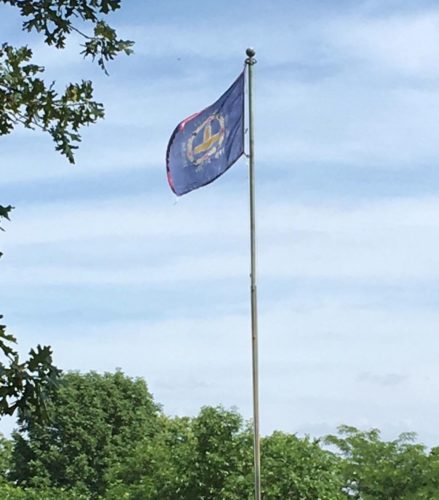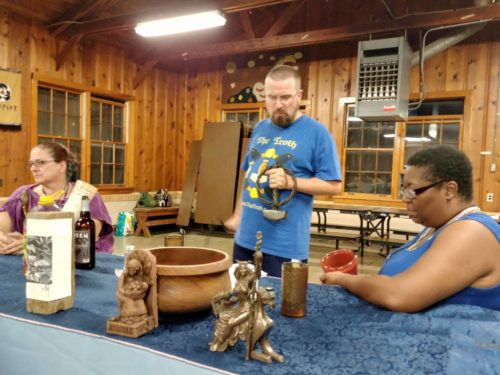![]()
The Troth held its 30th annual Trothmoot at Crowder State Park in Missouri from Thursday, June 1 through Sunday, June 4. To provide members in different regions equal opportunity to attend, the international Ásatrú and Heathen organization rotates the location of the gathering between western, midwestern, and eastern regions. This year, attendees arrived from 13 U.S. states and two Canadian provinces, with Illinois and Washington making the strongest showings.
On Thursday afternoon, attendees performed a blót to the god Tyr. The central ritual of Heathenry, blót is focused on the making of offerings to gods, goddesses, land spirits, and other figures. To open Trothmoot, participants honored the god described as presiding over community gatherings in the organization’s monumental text Our Troth, Volume One: History and Lore:
Tyr simply established a framework for managing the struggles and conflicts inherent in any community such that the community, rather than being torn apart, emerged stronger. To call Tyr, therefore, a god of right, after the German Recht, would come nearer to the truth, although perhaps the most accurate term would be Þing-god, after the institution with which Tyr was most closely identified in later Heathen times.

The Troth flag flies over Trothmoot [Lisa Cowley Morgenstern].
We followed the Troth’s traditions of honoring Tyr in blót and asking for his aid in maintaining the fellowship and frith [“peace”] of our community. Traditionally, we use a spear and a glove both as his hallowing tools and to represent the establishment of the frithstead and of a vé [“shrine”] to Tyr. We located the shrine by a flagpole and raised the Troth banner as an announcement of the taking of the land by the Troth.
We then walk the entire premises that we will utilize for our business meetings, rituals, workshops, and fellowship and honor the land wights in each of the cardinal directions, moving in a clockwise circle. This year we also stopped and hailed other deities along the route, particularly when we came across plants that bear an association with one in particular. For example, we hailed Thor at an oak tree and Holle at an elderberry bush.
On Sunday, we walked the same route counterclockwise, honored Tyr and other deities in a closing rite, disassembled the shrine, and took down the banner.
In one of the buildings of the campsite, members also set up individual shrines to Odin, Frigg, Holle, the Matronae, and several others.
Thursday night featured a presentation on “Speakers to the Dead” by Alvilldr in fägra, author of Sheathenry, Volume I: Ritual Practices of Modern Heathen Women. When I asked her to explain her work, she said,
Whether they study their genealogy, construct ancestor shrines where they give offerings, follow a predecessor’s career path, or visit the graves of their forebears to commune with the dead, Heathen women endeavor to create or continue relationships with their relatives who have gone to the afterlife.
This presentation utilized the voice recordings of many of the women I interviewed for my book in order for the audience to hear how various Heathen women honor their ancestors in their own voices.
Ben Waggoner, the organization’s shope (publications director), discussed the “Germanic Night Sky” late Thursday night. He explained names of specific stars and constellations in various Northern European societies and stated that “the shope will someday publish [his research] as a book, once he gets everything else out of the way, which is not likely to happen soon, so don’t hold your breath.” A lot of people — Heathen and not — are interested in learning more about Germanic star lore, so hopefully he will be able to publish some form of his work sooner rather than later.
Waggoner also presented an introduction to Old Norse language on Friday morning, preceded by Schreiwer’s introduction to Urglaawe, which the Troth steer defines — in his Dictionary of Urglaawe Terminology, written with Ammerili Eckhart — as “a Heathen path that is derived from the living, pre-Christian traditions of the Deitsch [Pennsylvania German] nation.”
During the rede (board) meeting on Thursday night and during the general business meeting on Saturday morning, several officers swore new or renewed oaths regarding their official roles. Last fall, the Troth amended the oath taken by all titled representatives so that it would to be more closely “aligned with the Troth’s mission and stated positions.” Reaffirming the organization’s commitment to inclusive Heathenry, the new passage in the relatively length oath reads:
With the Troth I stand against any use of Germanic religion and culture to advance causes of racism, sexism, homophobia, white supremacy, ableism, or any other form of prejudice.

Rede members renew oaths: Amanda T. Leigh-Hawkins, Lagaria Farmer, John T. Mainer, Robert L. Schreiwer [Lisa Cowley Morgenstern].
I didn’t know if I won a seat on the High Rede until the first evening of Trothmoot. I felt the weight of history associated with those who’ve held this office and the organization itself. It was a welcome feeling. I knew I would take my oath of office, and since I had only made a written oath as Steward, I knew I would speak my oath for that as well.
I stood in the Hall surrounded by members of the Troth as I grabbed the Troth oath ring. The High Steward and the Steer held the Ring as well. Each took a turn repeating the Troth’s officer oath that I spoke in return. That moment is one of the proudest achievements of my life that I shall never forget.
On Friday night, Winifred Hodge-Rose led a walk through a large maze that was constructed to represent the journey to Mimir’s Well of Wisdom at its center. Jamie Juliansdatter describes the experience of walking the maze:
Intentionally moving into the maze was an unexpected gift. It was both a shared experience in community and an individual journey that was perfectly orchestrated by Winfred Hodge-Rose and kindred members.
Participating in the maze (and Trothmoot) gave me permission I rarely give myself in the midst of so many mundane commitments – the permission to slow way down, enter into sacred space according to my own rhythm, and listen deeply for much needed wisdom.
The maze was an opportunity to connect and reflect, as well as a reminder that I need these experiences much more often than I get.
Late the same night, Diana L. Paxson led a ritual of “Spae (Oracular Seiðr),” which she calls “Germanic oracular practice” on her website, Seeing for the People: High Seat Seið and the Core Oracular Method. Trothmoot programmer Lorrie Wood describes Friday’s rite:
Every year on Friday night of Trothmoot, Diana reaches out to the local and regional Heathen community, and asks them to help her put on her oracular ritual. Here, attendees of the moot are encouraged to bring their most important questions, and the seers answer them.
Without tools, but as the result of talent, skill, and training, answers are direct and immediate, although there’s often Heathen imagery involved in an answer. Sometimes a question is asked directly of an ancestor or a god, and the seer will get their point of view of the answer, if possible.
Throughout the day on Saturday, Rosten (Dean Michael Rose) led a forge demonstration and helped interested people make Thor’s hammers and other objects of pewter. He reflects on his work:
So far as I can remember, I have nearly always showed up to Trothmoot with a forge. It is an activity that many find interesting, and some are even eager to give it a try! Usually there are a few that leave the gathering with a new skill.
In this line of work, one learns quite a bit as creations “whoosh up” in a communal setting. I brought a variety of tools and a few ideas but left it to the folk to actualize their ideas. I had not done much with the white metal before, but we all had fun, and a number of interesting works resulted. I left with more ideas than I came with.
This moot was different in that I did very little forging. However, a couple of members were busy at the fire, so the opportunity was theirs for the taking! It was a friendly crowd, so I was able to be a bit more relaxed leaving tools lying around.
Paxson led a blót to the goddess Idunn on Saturday afternoon. Attendees had been asked to bring water from their home regions to add to a bowl of “the waters of the world.” When each person or group’s turn came, they walked forward, explained where they had collected the water – stream, lake, well – and added it to the bowl. Schreiwer added water preserved from the Idunna blót of last year’s Trothmoot, and Paxson poured the water on the roots of the oak tree that stood over the main meeting area.

Diana L. Paxson prepares to pour the waters of the world on the roots of the oak tree [Karl E. H. Seigfried].
After the final feast prepared by Tanya Peterson and her staff of volunteers, the entire group met for the grand sumbel. In A Practical Heathen’s Guide to Asatru, former Troth steer Patricia M. Lafayllve defines sumbel as “a ritualized drinking ceremony which is meant to strengthen bonds within a community.” Two large drinking horns — providing a choice of mead or apple juice — were passed around the assembled participants. In the first round, each member hailed a god or goddess by giving a short or long speech and drinking from the horn. In the second round, ancestors or other departed individuals were hailed. The third round was open to whatever the participants chose to address.

Robert L. Schreiwer (center) opens the grand sumbel, with Lisa Cowley Morgenstern (left) and Lagaria Farmer (right) [Karl E. H. Seigfried].
Several attendees told me that attendance was noticeably down from previous years. In 2016, there were nearly two dozen more participants, and some earlier Trothmoots have had nearly three times as many attendees. Given that there has been a steady increase of new memberships in the organization, Wood suggests that the lower numbers this year may be due to a lack of current members in the midwestern region. She says that this year’s location was deliberately chosen to build a stronger presence in the area: “Trothmoot hasn’t been held in the Midwest since 2010, but as a committee we felt it imperative to hold the moot there to help grow our membership in that part of the country.”
Members of the Trothmoot planning committee are already looking at locations near Baltimore, Nashville, and Philadelphia as possible sites for next year’s event. There was a feeling among some members that, after many years of Trothmoots held at campgrounds, it might be nice to finally meet somewhere with a swimming pool and air conditioning.
* * *
The views and opinions expressed by our diverse panel of columnists and guest writers represent the many diverging perspectives held within the global Pagan, Heathen and polytheist communities, but do not necessarily reflect the views of The Wild Hunt Inc. or its management.
The Wild Hunt is not responsible for links to external content.
To join a conversation on this post:
Visit our The Wild Hunt subreddit! Point your favorite browser to https://www.reddit.com/r/The_Wild_Hunt_News/, then click “JOIN”. Make sure to click the bell, too, to be notified of new articles posted to our subreddit.
